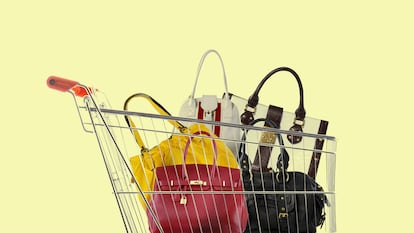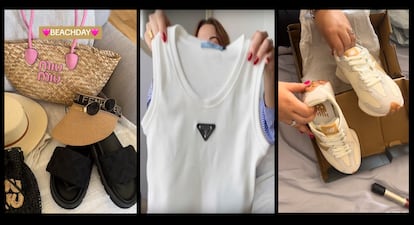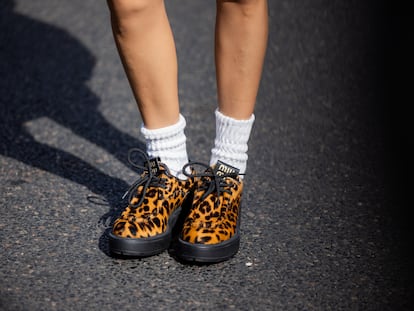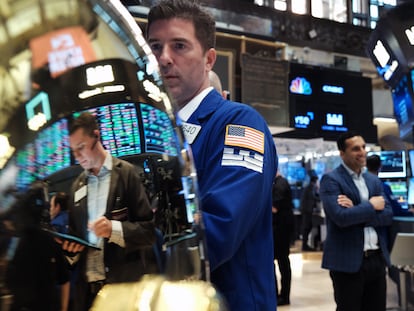Bootleg influencers: How Gen Z is flaunting designer knockoffs that are bought online
On social media, dozens of young people are showing off imitation luxury bags they bought via different digital platforms — and they have no problem admitting they’re not the real deal

Prada sunglasses, a Jacquemus bag, another bag by Yves Saint-Laurent, New Balance and Adidas Samba sneakers… a young man shows off his latest purchases, carrying out a classic unboxing as he tells the camera about the quality, packaging and even the scent of each item. Behind him are shelves full of designer bags and sneakers. In the comments, his followers ask for “the links” to purchase their own bounty. But this is no influencer living in the lap of luxury; rather, he is a savvy expert with ties to an app specializing in counterfeit consumer goods. He is one of many such vendors who populate TikTok, and whose videos, on occasion, can reach a half-million views. Last year, as found by a study carried out by the European Union Intellectual Property Office (EUIPO), European companies lost $54 billion and failed to produce some 416,000 jobs due to such enterprises. Fashion and perfume head the list of objects that are most often falsified.
The rise of digital ultra-fast fashion companies like Shein and Temu have attracted some young people to the game of so-called “hauls,” huge orders of very cheap clothing that is usually worn once and then resold on platforms like Vinted or returned. Given the uptick of this consumption model, it was only a matter of time before digital trade in counterfeit brands proliferated. “The rise of these applications in the wake of the Covid pandemic is a complex phenomenon with multiple causes. The economic crisis has driven consumers to seek cheaper alternatives, while the rise of e-commerce has created an environment conducive to such transactions. Improvement in the quality of replicas, combined with a shift in young people’s consumption priorities, has blurred the line between authentic and fake. The lower perceived risk in online shopping and the anonymity offered by apps have facilitated this illegal market,” Pedro Mir Bernal, an academic and research director and professor of marketing and consumer behavior at ISEM Fashion Business School, tells EL PAÍS.
A search for the names of a few of these apps on TikTok yields more than 20 million results. Among the social network’s operating guidelines there is the rule of “not publishing, sharing or sending any content that breaches or infringes the copyright, trademarks or other intellectual property rights of third parties.” That is why the purchase of such imitations largely takes place through hidden links that influencers distribute privately, or via Telegram, where there are numerous groups with hundreds of members in which distributors, mostly from China or Korea, provide photos and prices for each knock-off, ranging from classic handbags from the best-known brands that can cost between $2,170 and $6,512 in stores, to sneakers and jeans from mid-range brands whose original prices don’t rise above $217. One can even find garments that recently made their debut on international catwalks. The fake fashion market has expanded to the point where it is able to provide shoppers with nearly anything, not just luxury, and it has become much more sophisticated in the way it does so. Forget the poorly made copies of iconic bags and t-shirts sold by street vendors, or the slightly better versions found in semi-underground flea markets. The digitization of counterfeit sales allows for access to thousands of models and colors of stealthy knock-offs. Apps now cater to a much more knowledgeable, niche customer who follows in the steps of experts when it comes to buying fakes online. According to a recent report published by Wired, it is estimated that with the help of influencers, there was a 26% increase in counterfeiting by Chinese sellers in 2023 compared to the previous year.
Bootleg influencers get discounts and gifts for providing links to connect their followers to such garments, making them something like the ambassadors of knockoff goods. Later, when they want to sell the same fakes on secondhand sale platforms like Vinted or Vestiare Collective, they alert their followers by uploading an unrelated image — a photo of a pen, for example — even though buyers will actually receive a fake bag or shoes, so dodging the anti-copyright-violation policy of secondhand fashion websites.

“It’s not worth what it costs”
When we asked a user, via direct message, about their penchant for buying fakes, they said that “the designs are the same and the brands inflate prices. It’s not worth it to pay that amount.” It’s a common argument among these young people: “Brands are deceiving us,” says another user, and while it’s true that, despite the intangible allure of certain logos and the years of history that they represent, many luxury brands aren’t very open about where and under what conditions their products are made. “Who cares if it’s fake if it’s the same thing,” says another user. This is perhaps the primary difference with the new wave of bootleg shoppers: they’re not ashamed of their fakes being fake.
Although the majority of market studies report that Gen Z is full of activists who care about sustainability, a recent investigation carried out by The Business of Fashion and McKinsey & Company consultants directly addresses the issue: 54% of them are OK with other people wearing knockoffs and 37% admit to having worn them themselves, or that they would wear them. “They are young people who unreservedly show off their knockoff luxury items, particularly bags. That breaks with the traditional taboo that exists around knockoffs, reflecting a significant change in Gen Z’s attitudes towards brands and consumption,” says Mir Bernal. “This apparent boycott of luxury is based on this generation’s various distinctive characteristics. Their strong social and environmental consciousness brings them to question the luxury industry’s practices, which are seen as elitist and hardly sustainable. Authenticity, a fundamental value among young people, is redefined: it’s no longer about the product’s authenticity, but rather, the personal honesty that comes from admitting that it’s a knock-off,” he says.
“My nephews (who are 13 and 17 years old) buy garments of suspicious quality: zippers that break, letters that wear off — but they don’t care, the important thing is wearing a huge logo,” says a co-worker. Because in this tangle of applications, hidden links and Telegram groups, there are also deals: leather bags for $217 and $11 plastic bags. In fact, last summer The New York Times published an extensive report on the rise of “superfakes”; knockoff bags whose prices average between $542 and $1,085 and are of a very similar quality to that of the original. They are manufactured in China and there are dozens of people who make a living acting as intermediaries between the factories that make them and Western buyers. They are practically indistinguishable. Not even the large second-hand luxury platforms, despite their teams of experts, are capable of parsing them with complete accuracy: Vestiaire Collective shared in its most recent report that it employs 90 authentication and 50 quality control experts throughout its six facilities around the world, a small number for its volume of sales: the company sold 2.5 million articles last year. They confirm that the number of bags that they have clocked as counterfeit is around 4.64%. In 2023, Amazon seized seven million counterfeit products, one million more than in 2022. The corporation’s anti-fraud team is made up of about 15,000 employees and makes an annual investment towards stopping the sale of knockoffs to the tune of $1.2 billion.
According to figures from Europol, it is estimated that the sale of knockoffs represents 2.5% of global trade. In Europe, 5% of imports are pirated goods. Beyond the fact that they are very cheap products, fake or not, the purchasing of knockoffs on the black market is “the second-most-profitable kind of criminal trafficking, behind only arms trafficking. It makes organized crime rich and takes money from countries through the loss of employment,” say sources from the Spanish office of patents and brands.
For their part, the fashion and luxury industries are facing the problem with medium-term solutions. Knockoffs have always existed, but for the first time, people are now proud to buy them in digital environments that are becoming ever-more rife with fake goods. Two years ago, the companies that own major brands in the sector (LVMH, Kering, OTB and the Prada group) founded Aura Consortium, a digital tool that guarantees the authenticity of their products via a QR code that redirects the user to blockchain. Through using it, consumers can know the origin of their bag, even if it was not purchased in one of the brand’s stores. But such steps are not enough. According to Mir Bernal, “this new consumer trend raises questions about the future of luxury brands and how they must adapt to remain relevant for this generation. Are we facing the beginning of a revolution in the perception of luxury or is it a passing phase of youthful rebellion? Only time will tell.”
Sign up for our weekly newsletter to get more English-language news coverage from EL PAÍS USA Edition
Tu suscripción se está usando en otro dispositivo
¿Quieres añadir otro usuario a tu suscripción?
Si continúas leyendo en este dispositivo, no se podrá leer en el otro.
FlechaTu suscripción se está usando en otro dispositivo y solo puedes acceder a EL PAÍS desde un dispositivo a la vez.
Si quieres compartir tu cuenta, cambia tu suscripción a la modalidad Premium, así podrás añadir otro usuario. Cada uno accederá con su propia cuenta de email, lo que os permitirá personalizar vuestra experiencia en EL PAÍS.
¿Tienes una suscripción de empresa? Accede aquí para contratar más cuentas.
En el caso de no saber quién está usando tu cuenta, te recomendamos cambiar tu contraseña aquí.
Si decides continuar compartiendo tu cuenta, este mensaje se mostrará en tu dispositivo y en el de la otra persona que está usando tu cuenta de forma indefinida, afectando a tu experiencia de lectura. Puedes consultar aquí los términos y condiciones de la suscripción digital.
More information
Archived In
Últimas noticias
Most viewed
- Sinaloa Cartel war is taking its toll on Los Chapitos
- Oona Chaplin: ‘I told James Cameron that I was living in a treehouse and starting a permaculture project with a friend’
- Reinhard Genzel, Nobel laureate in physics: ‘One-minute videos will never give you the truth’
- Why the price of coffee has skyrocketed: from Brazilian plantations to specialty coffee houses
- Silver prices are going crazy: This is what’s fueling the rally











































